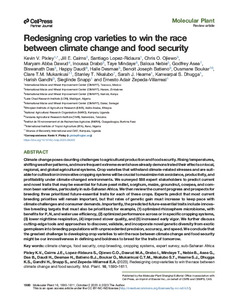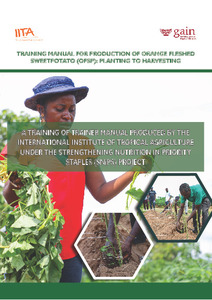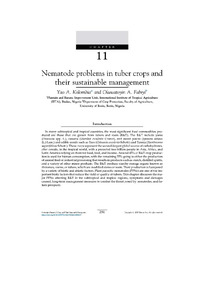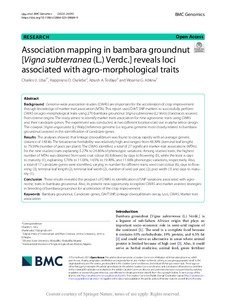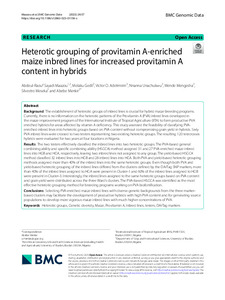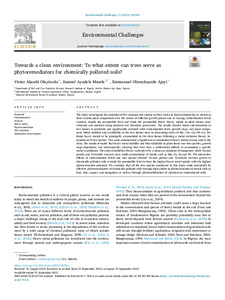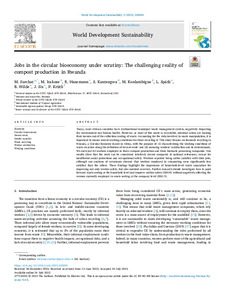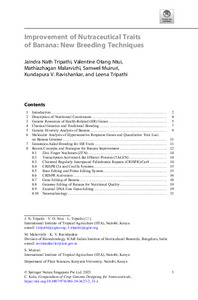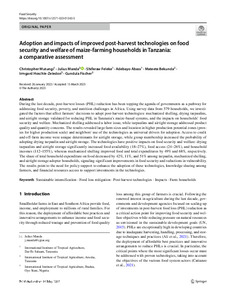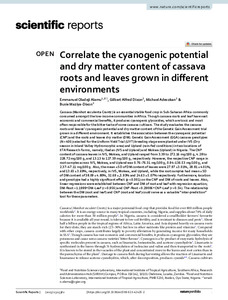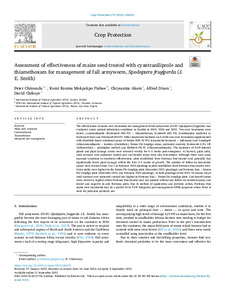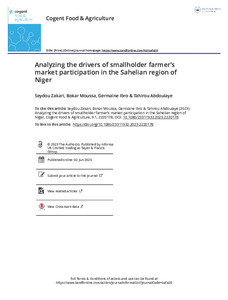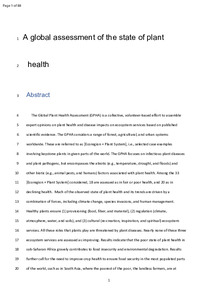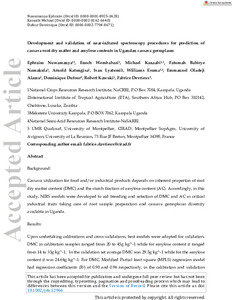Welcome to the International Institute of Tropical Agriculture Research Repository
IITA Bibliography System: Recent submissions
Now showing items 341-360 of 8094
-
Redesigning crop varieties to win the race between climate change and food security
(2023-10)Climate change poses daunting challenges to agricultural production and food security. Rising temperatures, shiftingweatherpatterns,andmore frequent extremeeventshave alreadydemonstratedtheir effectsonlocal, regional, and global agricultural systems. Crop varieties thatwithstand climate-related stresses and are suitable for cultivation in innovative croppingsystemswillbe crucial tomaximize risk avoidance, productivity, and profitability under climate-changed environments. We surveyed 588 expert ... -
Training of trainer manual for production of Orange Fleshed Sweetpotato (OFSP): planting to harvesting
(IInternational Institute of Tropical Agriculture, 2023-07)Sweetpotato (Ipomoea batatas) originated in Central America or north-western South America from where it was introduced to Europe, Africa, Asia and North America in more recent times. Sweetpotato is now cultivated in nearly all parts of the tropics and sub-tropics as well as in the warmer parts of the temperate regions (CIP, 2019). This is because Sweetpotato is a dry-land crop, tolerant to a wide range of edaphic and climatic conditions. It is more tolerant of cold than other tropical root and ... -
Cutting dipping application of Flupyradifurone against cassava whiteflies Bemisia tabaci and impact on its parasitism in cassava
(2023-09-30)The cassava whitefly Bemisia tabaci causes damage in cassava through the feeding and vectoring of plant viruses that cause cassava mosaic and cassava brown streak diseases. This study sought to explore the efficacy of cutting dipping in flupyradifurone for whitefly control and the impact of the mode of application on whitefly parasitism under farmer field conditions. The insecticide treatment significantly reduced adult whiteflies by 41%, nymphs by 64%, and cassava mosaic disease (CMD) incidence ... -
Nematode problems in tuber crops and their sustainable management
(Elsevier, 2023)In many subtropical and tropical countries, the most significant food commodities produced are those that are grown from tubers and roots (R&T). The R&T include yams (Dioscorea spp. L.), cassava (Manihot esculenta Crantz), and sweet potato (Ipomoea batatas (L.) Lam.) and edible aroids such as Taro (Colocasia esculenta Schott.) and Tannia (Xanthosoma sagittifolium Schott.). These crops represent the second-largest global source of carbohydrates, after cereals, in the tropical world, with a projected ... -
Association mapping in bambara groundnut [Vigna subterranea (L.) Verdc.] reveals loci associated with agro-morphological traits
(2023-10-06)Background Genome-wide association studies (GWAS) are important for the acceleration of crop improvement through knowledge of marker-trait association (MTA). This report used DArT SNP markers to successfully perform GWAS on agro-morphological traits using 270 bambara groundnut [Vigna subterranea (L.) Verdc.] landraces sourced from diverse origins. The study aimed to identify marker traits association for nine agronomic traits using GWAS and their candidate genes. The experiment was conducted at ... -
Heterotic grouping of provitamin A-enriched maize inbred lines for increased provitamin A content in hybrids
(2023-09-27)Background The establishment of heterotic groups of inbred lines is crucial for hybrid maize breeding programs. Currently, there is no information on the heterotic patterns of the Provitamin A (PVA) inbred lines developed in the maize improvement program of the International Institute of Tropical Agriculture (IITA) to form productive PVA enriched hybrids for areas affected by vitamin A deficiency. This study assessed the feasibility of classifying PVA-enriched inbred lines into heterotic groups ... -
Towards a clean environment: to what extent can trees serve as phytoremediators for chemically polluted soils?
(2023)The study investigated the potential of five common tree species in West Africa to bioaccumulate heavy metals in their various plant components over the course of different growth phases and at varying contamination levels (control, double the permissible level and triple the permissible limit). Heavy metals in plant tissues were extracted and analyzed using standard wet chemistry procedures. The results showed metal concentrations in tree tissues to positively and significantly correlate with ... -
Scale up trials to validate modified crops' benefits
(2023-09-21) -
Jobs in the circular bioeconomy under scrutiny: the challenging reality of compost production in Rwanda
(2023-12)Today, most African countries have dysfunctional municipal waste management system, negatively impacting the environment and human health. However, as most of this waste is recyclable, informal actors are making their income out of the collection/sorting of waste. Accounting for the risks involved in waste manipulation, it is important to ensure decent working conditions for those recycling it. This study focuses on biowaste recycling in Rwanda, a Circular Economy leader in Africa, with the purpose ... -
Improvement of nutraceutical traits of banana: new breeding techniques
(Springer, 2023-07-07)Banana (Musa spp.) is an herbaceous, everlasting green monocotyledonous plant belonging to the family Musaceae. It is a major staple crop after rice, maize, wheat, potato and cassava, and it has a high potential to contribute to food and nutrition security. It is an excellent fruit full of micronutrients, especially vitamin A, iron, potassium, and magnesium, and is a source of energy for millions of inhabitants of tropical and subtropical regions. Despite these qualities, banana is still lacking ... -
Adoption and impacts of improved post-harvest technologies on food security and welfare of maize-farming households in Tanzania: a comparative assessment
(2023-05-16)During the last decade, post-harvest losses (PHL) reduction has been topping the agenda of governments as a pathway for addressing food security, poverty, and nutrition challenges in Africa. Using survey data from 579 households, we investigated the factors that affect farmers’ decisions to adopt post-harvest technologies: mechanized shelling, drying tarpaulins, and airtight storage validated for reducing PHL in Tanzania’s maize-based systems, and the impacts on households’ food security and ... -
Development of an improved steamer for optimum retention of carotenoids in Attieke produced from biofortified cassava (Manihot esculenta Crantz) roots
(2023)Attiéké, made from biofortified (yellow) cassava genotypes, requires a new cooking method to minimize carotenoid degradation during processing. Thus, this research is aimed at designing and building a more efficient steamer to produce high-quality attiéké from biofortified cassava roots. Using three improved biofortified cassava genotypes (IBA141092, IBA070593, and IBA011368) obtained from IITA research farms, attiéké samples were produced using traditional and developed steamers. The results show ... -
Habitat range shift and prediction of the potential future distribution of Ricinodendron heudelotii (Baill.) Heckel in Benin (West Africa)
(2023)Ricinodendron heudelotii (Baill.) Heckel is an important nutraceutical reservoir. Its Sustainable exploitation requires information on its potential distribution in the current context of rapid population growth and climate change threats. This study aimed to map the suitable areas for its domestication and conservation under current and future climate conditions in Benin. Occurrence data were recorded and combined with the environmental layers of two climatic scenarios (optimistic RCP 4.5 and ... -
Correlate the cyanogenic potential and dry matter content of cassava roots and leaves grown in different environments
(2023)Cassava (Manihot esculenta Crantz) is an essential stable food crop in Sub-Saharan Africa commonly consumed amongst the low-income communities in Africa. Though cassava roots and leaf have vast economic and commercial benefits, it produces cyanogenic glycosides, which are toxic and most often responsible for the bitter taste of some cassava cultivars. The study evaluates the cassava roots and leaves’ cyanogenic potential and dry matter content of the Genetic Gain Assessment trial grown in a different ... -
Effects of traditional preparatory techniques on the chemical and pasting characteristics of yellow-fleshed cassava roots (Manihot esculenta)
(2023)Understanding the interactions between chemical and pasting properties and conventional cooking methods will help utilise yellow-fleshed cassava roots. Thus, the study examined how conventional processing affected Nigerian yellow-fleshed cassava's chemical and pasting properties. Three improved, yellow-fleshed genotypes were harvested 12 months after planting: 01/1371 (high carotenoids, 7.3 μg/g on Fresh weight basis (FW)), 01/1235 (medium, 4.8 μg/g FW), and 94/0006 (low, 2.6 μg/g FW). The peeled ... -
Assessment of effectiveness of maize seed treated with cyantraniliprole and thiamethoxam for management of fall armyworm, Spodoptera frugiperda (J. E. Smith)
(2023-12)The effectiveness of maize seed treatments for management of fall armyworm (FAW) (Spodoptera frugiperda) was evaluated under natural infestation conditions in Zambia in 2019, 2020 and 2022. Two seed treatments were tested: cyantraniliprole (Fortenza® 600 FS) + thiamethoxam (Cruiser® 600 FS) (combination marketed as Fortenza® Duo) and Fortenza® 600 FS. Other treatments included each of the two seed treatments supplemented with threshold-based rotational sprays of Denim Fit® 50 WG (emamectin benzoate ... -
Drivers of consumer acceptability of cassava gari-eba food products across cultural and environmental settings using the triadic comparison of technologies approach (tricot)
(2023-07-18)BACKGROUND Nigeria and Cameroon are multi-ethnic countries with diverse preferences for food characteristics. The present study aimed to inform cassava breeders on consumer-prioritized eba quality traits. Consumer testing was carried out using the triadic comparison of technologies (tricot). Diverse consumers in villages, towns and cities evaluated the overall acceptability of eba made from different cassava genotypes. Data from both countries were combined and linked to laboratory analyses of eba ... -
Analyzing the drivers of smallholder farmer’s market participation in the Sahelian region of Niger
(2023-06-02)Many sub-Saharan farmers rely on agricultural production for home consumption and sell crops to meet their other needs. Farmers’ market intervention enhances economic expansion and helps to improve household food security. In our current study, we strive to explore the determinants of farmers’ decisions and the intensity of market participation in the Sahelian region of Niger, where little has been published, thereby filling the gap in the literature. A double hurdle approach was employed to achieve ... -
A global assessment of the state of plant health
(2023)The Global Plant Health Assessment (GPHA) is a collective, volunteer-based effort to assemble expert opinions on plant health and disease impacts on ecosystem services based on published scientific evidence. The GPHA considers a range of forest, agricultural, and urban systems worldwide. These are referred to as [Ecoregion × Plant System], i.e., selected case examples involving keystone plants in given parts of the world. The GPHA focuses on infectious plant diseases and plant pathogens, but ... -
Development and validation of near-infrared spectroscopy procedures for prediction of cassava root dry matter and amylose contents in Ugandan cassava germplasm
(2023-09-04)Background Cassava utilization for food and/or industrial products depends on inherent properties of root dry matter content (DMC) and the starch fraction of amylose content (AC). Accordingly, in this study, NIRS models were developed to aid breeding and selection of DMC and AC as critical industrial traits taking care of root sample preparation and cassava germplasm diversity available in Uganda. Results Upon undertaking calibrations and cross-validations, best models were adopted for validation. ...

